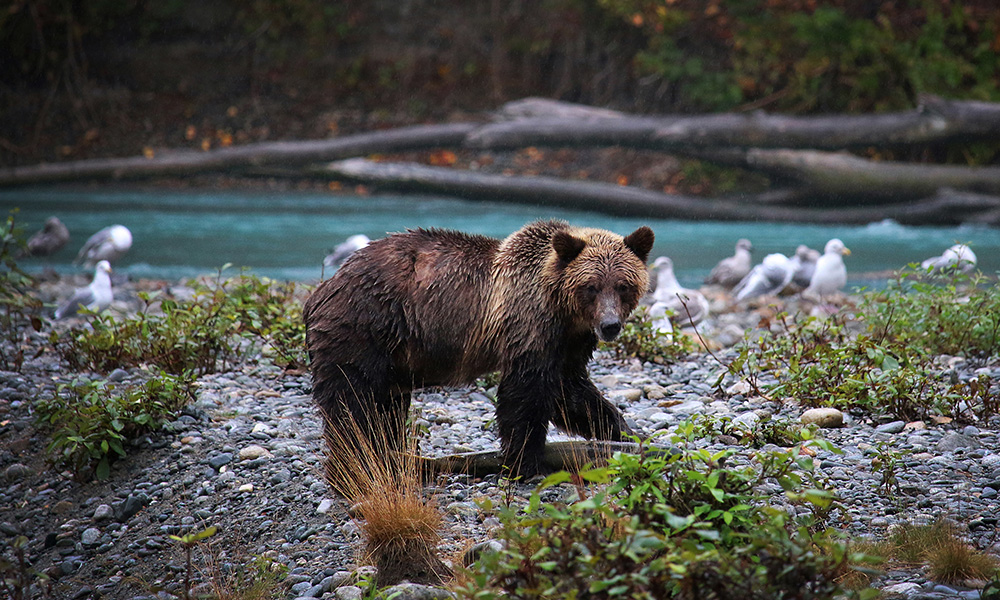
A UBCO researcher suspects misadventures with traps set to catch small furbearing animals are causing grizzly bears to damage and lose their front toes.
A UBC Okanagan researcher is suggesting changes to fur trapping practices to help prevent the accidental amputation of grizzly bear toes.
Dr. Clayton Lamb’s latest research, published recently in Wildlife Society, is calling attention to a small number of grizzly bears in the southeast corner of British Columbia missing toes on their front paws. While it’s not a large number of bears, Dr. Lamb says there is enough data to confirm that the accidental amputations, likely due to fur trapping bycatch, are frequent enough to raise concern.
Now a postdoctoral researcher with UBCO’s Irving K. Barber Faculty of Science, and an experienced trapper himself, Dr. Lamb conducted a live-capture research project to better understand grizzly bear mortality as part of his PhD work at the University of Alberta. Lamb captured and collared almost 60 grizzlies. He noticed several of the bears were missing some of their front toes.
“These were not birth defects,” says Lamb. “Identifying how those toes were amputated and mitigating the source of amputation became one of the objectives of this study.”
Of the 57 bears captured, four were missing toes on one of their front feet, which could make it hard for the bears to dig for food or defend themselves. While the injuries had healed, they were all similar and Lamb suggests the wounds were from a misadventure with a trap designed to catch furbearers.
Small body‐gripping traps are used to capture martens or weasels and are typically set with a baited box attached to a tree, he explains. They can be set in early November and remain in place until late winter.
The researchers discussed the issue with trappers, Indigenous communities, scientists, conservation officers, wildlife managers and guide outfitters. Comparing data from other collaring projects in adjacent areas of BC, they found a pattern to the toe loss and even confirmed reports of grizzly bears killed with small mammal body-gripping traps still on their feet.
To test their theory, they set up four small mammal body-gripping traps—rigged so the traps could trigger but not fully close—and monitored them with remote cameras for two weeks. Grizzly bears visited all four traps and sprung two of them.
“Even with the small sample, it was clear that baited traps attracted bears and that bears set off the traps to get the food. We have pictures and videos showing the bears investigating the traps and manipulating the boxes with their paws.”
The researchers also determined it wasn’t the initial snap of the trap that caused the bears to lose their toes, but the prolonged duration of the trap stuck on their foot.
“The bone loss observed in the bears either happened from a weakening of the bone during necrosis and infection, or from force applied to the bone from the trap while the bear walked or ran with the trap still on its foot.”
Small mammal trapping is generally done in the early winter when fur is prime and most valuable. While some trappers voluntarily delay the start of their marten and weasel trapping season, Dr. Lamb is suggesting an official delay from November 1 to early December to buy the bears time to fully hibernate.
“Shifting the start of most trapping that coincides with the active bear season would eliminate the overlap, and trappers should generally be able to avoid accidentally catching bears,” he says. “This not only reduces the risk to the bears, but also prevents the traps from being destroyed by the bears.”
Another suggestion involved a different trap with a smaller, constricted entrance so most bear paws could not fit inside to grab the bait.
Neither suggestion is perfect. Dr. Lamb recognizes both will impact the trappers’ livelihood and require compliance monitoring, adding additional responsibilities to conservation officers.
“The most viable solution to the amputated toe issue requires that bears’ feet do not enter these traps at all,” he says. “The solutions we present have various pros and cons, and we hope this work can help policy-makers choose a solution that will resolve the amputated toe issue while ensuring trappers continue to have the important opportunity to trap furbearers.”